Categories: How does it work
Number of views: 57995
Comments on the article: 1
Electric bell device
 Since childhood, we have known the button above the door to an apartment or building. When you click on it, the owner is given a sound signal - a melodic ringing of a bell or a simple musical composition warning about the appearance of a guest.
Since childhood, we have known the button above the door to an apartment or building. When you click on it, the owner is given a sound signal - a melodic ringing of a bell or a simple musical composition warning about the appearance of a guest.
This is how an ordinary electric bell works. We will disassemble its design without affecting electronic models on multivibrators, microcircuits, and other components.
The electric bell has existed for two centuries, uses the energy of the electromagnetic field. His household structures are powered by current:
1. constant value;
2. with a variable sinusoidal harmonic, usually supplied with a voltage of 220 volts.
Principle of operation and direct current electric bell device
To create sound waves, the impacts of a small malleus are used in the form of a steel ball located at the end of a springy plate, which, upon mechanical vibrations, strikes the bell.
This hammer is stationary mounted on a movable anchor, capable of moving relative to a fixed fulcrum. Here are mounted:
-
the movable part of the composite magnetic core of the electromagnet;
-
a spring with a device for adjusting the force to return the armature to its original position, which works after an open circuit of the electric current supply
-
movable contact switching the supply of voltage to the electromagnet coils.
Around the magnetic circuit there are two electric coils with windings connected in series. When direct current passes through the coils, a magnetic flux is created in the magnetic circuit, the magnitude of which is summed from the fluxes of each coil and is many times higher than the values that arise in a single wire. Cm. - Inductors and magnetic fields.
The magnetic force created by the magnetic circuit can reach large quantities and perform significant mechanical work. In our case, it is used to rotate the anchor: pull it to the stationary part in order to perform a hammer blow on the bell.
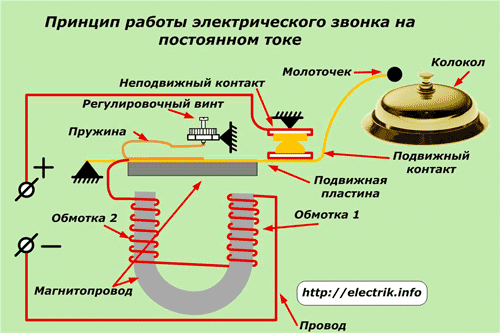
The source of voltage / current in the circuit can be a specific galvanic cell (battery or accumulator), or a rectifier device, powered from a source of variable electrical energy.
In the above diagram, the button with mechanical self-reset is not shown, when pressed, the current from the source is supplied to the electric circuit of the bell. It is shown in the picture below.
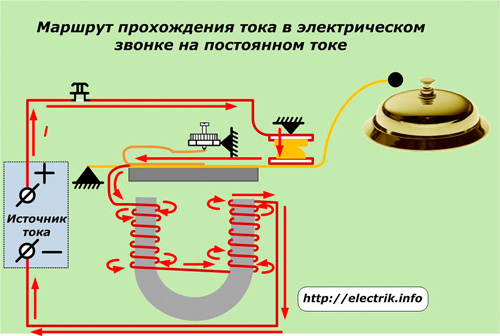
When the button is pressed, a closed circuit is created for passing electric current I through the laid wires from the “plus source” through the closed contact group to the conductive plate of the armature and through the windings of the coils to the “minus source”.
A magnetic flux is induced in the magnetic circuit.
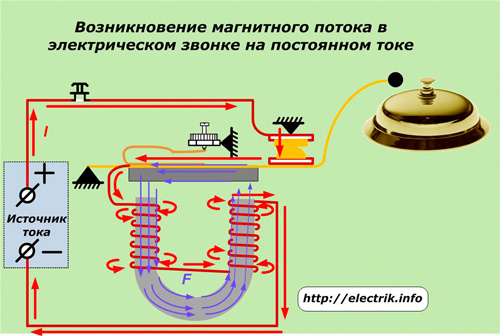
It forms a mechanical force F, turning the anchor and pulling it to the fixed part.
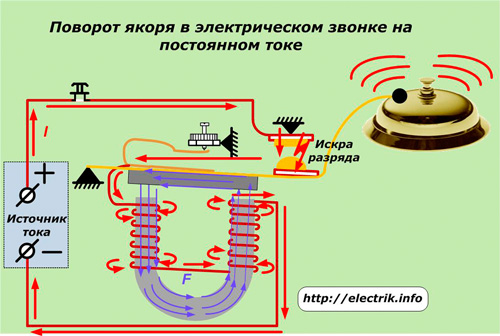
At the same time, the hammer knocks on the bell, causing a ringing, and the movable contact departs from the stationary fixed. An electric spark jumps between them. At the same time, a mechanical spring stretches and its tension increases.
After the extinction of the spark through the open contact group, the movement of electric charges stops, the current disappears, the magnetic flux disappears.
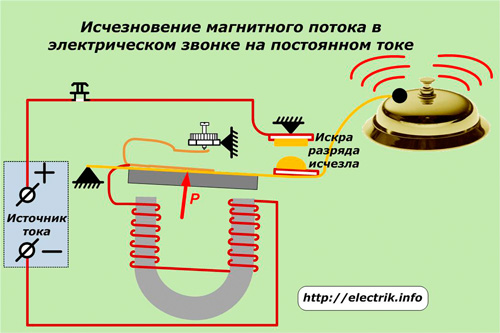
Only the spring pull force P acts under the influence of which it returns to its original position. At the same time, if the bell button remains pressed, then an electric current again arises in the circuit for delivering repeated and subsequent hammer blows to the bell.
As a result, the call will sound until the visitor presses the button. In practice, there are schemes that limit the duration of the sound.They are based on the insertion into the current circuit of an additional normally closed contact, which is controlled by a triggered timer. But this method complicates the design and is not always justified.
The sequence of dynamics of the processes occurring during operation is demonstrated by an animated picture.
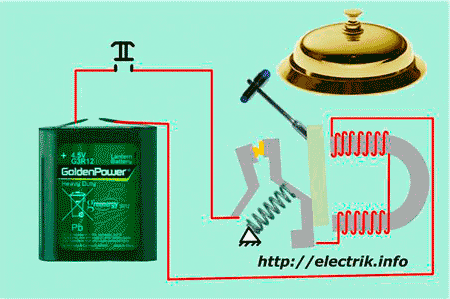
You can control an electric call from different places. To do this, just connect an additional button or group of them for installation in different rooms in parallel with the button contacts. In the 19th century, the owners of large houses used this method to call servants to themselves.
All electrical and magnetic characteristics of coils, wires, contacts, buttons and power supplies are calculated and selected at the factory in accordance with the arising thermal loads and mechanical forces for reliable operation.
DC calls are used in older telephones, alarm systems, fire protection and other devices.
Of particular concern in this scheme is the contact group. During operation, a spark discharge constantly jumps through it, which slowly but purposefully destroys the metal. This requires periodic inspections and preventive maintenance.
Principle of operation and device of an electric bell on alternating current
Electromagnetic energy of alternating current varies according to a harmonious sinusoidal law. Magnetic and electric fields constantly interact in time, are directed counter-relative to each other.
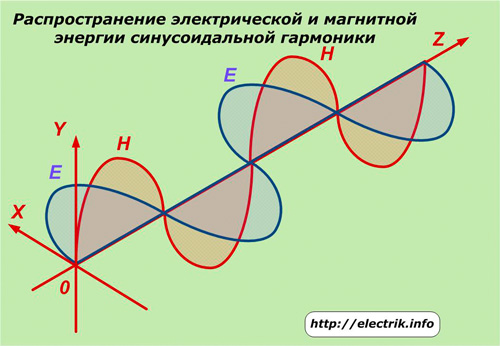
When passing through the coil, the direction and magnitude of the current in the magnetic circuit induces a magnetic flux of the corresponding shape. In the case of a correctly selected construction of parts, the movable part of the armature can be forced to make return movements in two directions under the action of magnetic force.
During the first swing, the bell is hit, and in the second, the hammer is pulled back to its original position to perform a subsequent blow. The frequency of current changes of 50 hertz will correspond to the frequency of the generated ringing.
According to this principle, the electric bell shown in the photo is created and works.
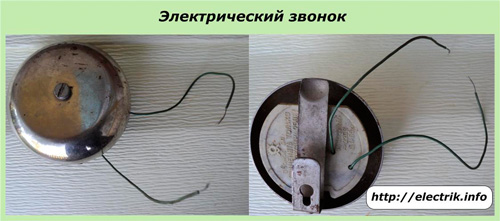
It was made in the 70s according to GOST 7220 66, approved in 1966, and has still retained its performance.
It consists of:
-
bell;
-
winding coil;
-
magnetic core with a shock plate and wall mounts;
-
wires for connecting to the circuit;
-
the screw for fastening the bell to the housing.
There is no contact group. This increases the reliability of the system, eliminates the need for frequent preventative maintenance.
After unscrewing the screw, all the components of an electric bell with an alternating sinusoidal current are visible.
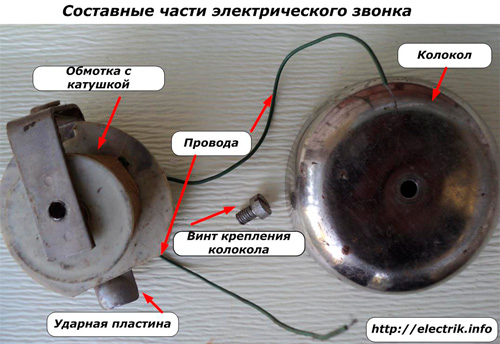
In more detail, their design and appearance can be seen in the pictures below.
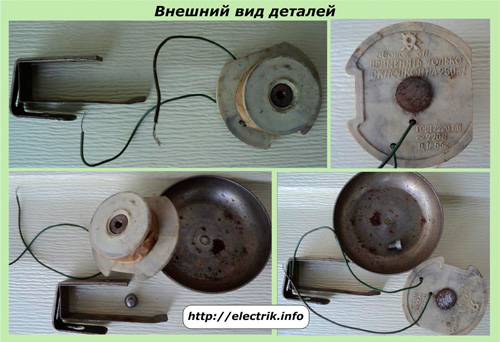
This design uses a voltage of 220 volts. It is present on all electrical parts of the circuit, including the button, which is considered a dangerous factor and requires monitoring of the insulation state. Connecting such a call to the network with buttons made for a lower voltage is dangerous and unacceptable.
In modern calls, the voltage to the winding and the button is reduced by the inclusion of step-down transformers in the circuit. 220 volts from the apartment network are supplied to their primary winding, and a low voltage is applied to the button and bell.
The transformer design on alternating current is found in telephones, signaling schemes of industrial installations.
Read also:About baby pranks or how to protect an apartment door from fire
See also at i.electricianexp.com
:
